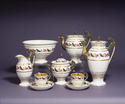 Growing prosperity among the middle-ranks led to increased consumption as they filled their larger houses with ever greater quantities of material possessions. Initially the preparation and refinement of sugar, rum and tobacco coming from the West Indies were perhaps the most important consumer industries, but soon there were potteries, glassworks, and jewellery firms responding to a rising demand.
Growing prosperity among the middle-ranks led to increased consumption as they filled their larger houses with ever greater quantities of material possessions. Initially the preparation and refinement of sugar, rum and tobacco coming from the West Indies were perhaps the most important consumer industries, but soon there were potteries, glassworks, and jewellery firms responding to a rising demand.
 By the 1820s there were potteries such as the Caledonian in Townhead, the Verreville in Finnieston and the Annfield in Bridgeton producing a range of earthenware, stoneware and china. Skills in the manufacture of woollen and linen goods were transferred to the cotton industry, with Glasgow becoming the major centre for muslin and fine weaving. Spinning became mechanised with ever larger spinning mules in mills, first around the city and then, with the coming of steam power, in the city itself. But it was much more difficult to mechanise fine weaving and handloom weavers remained the largest group of workers in the city - still nearly 10,000 in the 1830s.
By the 1820s there were potteries such as the Caledonian in Townhead, the Verreville in Finnieston and the Annfield in Bridgeton producing a range of earthenware, stoneware and china. Skills in the manufacture of woollen and linen goods were transferred to the cotton industry, with Glasgow becoming the major centre for muslin and fine weaving. Spinning became mechanised with ever larger spinning mules in mills, first around the city and then, with the coming of steam power, in the city itself. But it was much more difficult to mechanise fine weaving and handloom weavers remained the largest group of workers in the city - still nearly 10,000 in the 1830s.
 Cloth printing and dyeing works abounded, with Turkey red dyeing at the Barrowfield works, where Henry Monteith & Co in the early 19th century produced the ubiquitous Bandana handkerchief. Finished cloth was turned into clothes by a plethora of tailors, seamstresses and milliners working at home or in tiny workshops. Carpet manufacturing, first established in the 1750s, began to expand with James Templeton pioneering new techniques by the 1830s. Shoes, clothes, and furniture all tended to be produced in small workshops with producers selling directly to the public, although there were signs of merchant-manufacturers beginning to organise and regulate these trades for a national market.
Cloth printing and dyeing works abounded, with Turkey red dyeing at the Barrowfield works, where Henry Monteith & Co in the early 19th century produced the ubiquitous Bandana handkerchief. Finished cloth was turned into clothes by a plethora of tailors, seamstresses and milliners working at home or in tiny workshops. Carpet manufacturing, first established in the 1750s, began to expand with James Templeton pioneering new techniques by the 1830s. Shoes, clothes, and furniture all tended to be produced in small workshops with producers selling directly to the public, although there were signs of merchant-manufacturers beginning to organise and regulate these trades for a national market.
 Ale of many different kinds and quality was produced in a large number of small breweries, with Struthers’ Greenhead brewery becoming Scotland's largest. The first distillery arrived in 1786 in the Gorbals and, by the 1830s, the largest was McFarland & Co at Port Dundas.
Ale of many different kinds and quality was produced in a large number of small breweries, with Struthers’ Greenhead brewery becoming Scotland's largest. The first distillery arrived in 1786 in the Gorbals and, by the 1830s, the largest was McFarland & Co at Port Dundas.